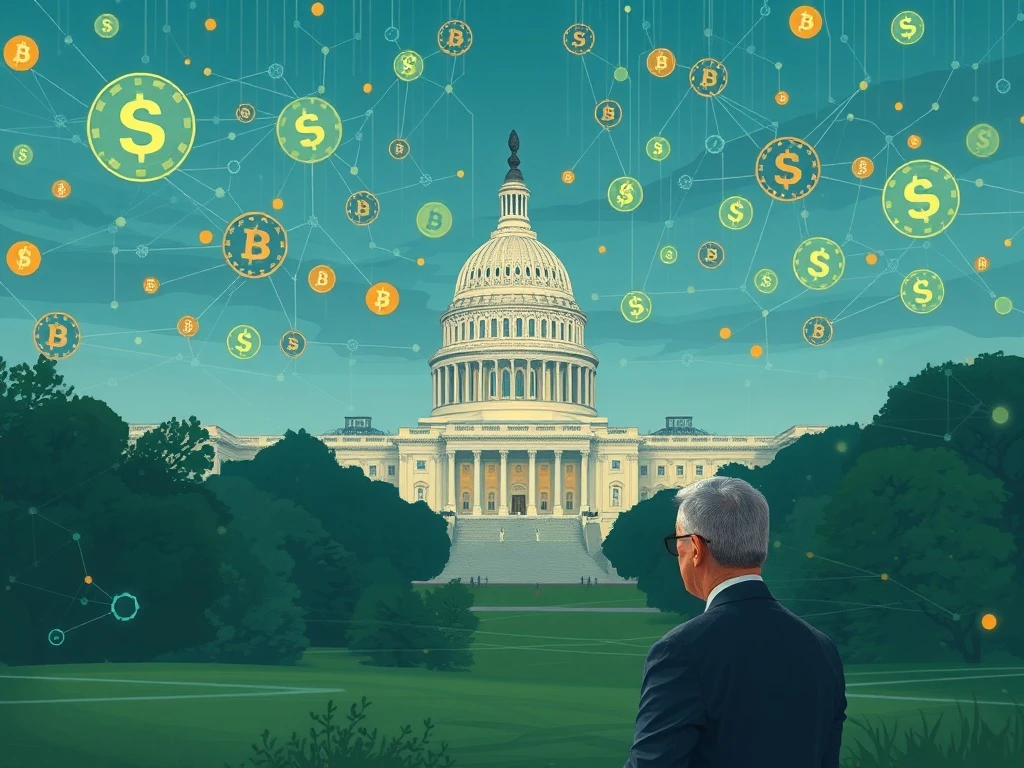SEC Crypto Regulation: US Urgently Pushes for Innovation, Says Chair Atkins

The United States faces a critical juncture in the burgeoning world of digital assets. Recently, SEC Chair Paul Atkins delivered a stark assessment. He declared the US is “10 years behind” on cryptocurrency adoption and policy. This pronouncement underscores a significant challenge for American competitiveness. Furthermore, Atkins stated that establishing a robust SEC crypto regulation is now the agency’s primary objective. This ambitious goal aims to reclaim leadership in the global crypto space. The Securities and Exchange Commission is actively working to build a supportive environment. They seek to attract innovation and talent back to American shores.
The Urgent Call for US Crypto Innovation
During a recent event in Washington, D.C., SEC Chair Paul Atkins made his position clear. He believes the United States significantly lags in its approach to digital assets. Atkins stated, “the crypto aspect is our job one.” This sentiment highlights a crucial shift in the agency’s priorities. The SEC aims to develop a comprehensive regulatory framework. This framework intends to foster rather than hinder progress. Its primary purpose is to encourage individuals and companies to operate within the US. Atkins explicitly mentioned attracting those who “may have fled” due to regulatory uncertainty. Moreover, the agency wants this new structure to allow “innovation to thrive.” This signals a proactive stance from the regulator. Atkins even quipped, “I like to say that we’re the securities and innovation commission now.” This new self-description reflects a forward-thinking mindset. It emphasizes the dual role of protecting investors and promoting technological advancement. Therefore, the focus is squarely on driving US crypto innovation.
The implications of this statement are substantial. A decade-long lag suggests missed opportunities and potential economic disadvantages. Consequently, the SEC’s commitment to catching up is paramount. They recognize the need for a clear and predictable regulatory environment. This environment will ideally reduce uncertainty for businesses. It will also provide clearer guidelines for developers. Furthermore, it seeks to reassure investors about market integrity. The SEC’s renewed focus could unlock significant economic potential. It could also solidify the US position in the global digital economy. The agency is dedicating considerable resources to this complex task. They understand the stakes involved are incredibly high.
Crafting a Robust Regulatory Framework
Developing a suitable regulatory framework for cryptocurrencies is a top priority for the SEC. Atkins explained this effort as part of a broader “embrace of innovation.” The agency is dedicating significant time and resources to this complex area. This commitment suggests a serious intent to address current regulatory gaps. Atkins also hinted at a promising development: an “innovation exemption.” This mechanism would allow for controlled experimentation with new ideas and technologies. Such exemptions are crucial for novel industries. They provide a safe space for development without immediate, burdensome compliance. Atkins clarified the SEC’s authority in this regard. “We at SEC with respect to our statutes have pretty broad authority for exemptions to be made,” he stated. He further emphasized, “I think we can be, you know, very forward-leaning in that in order to accommodate new ideas.” This flexibility is vital for adapting to rapidly evolving technologies. It demonstrates a willingness to move beyond traditional regulatory models. The goal is to create pathways for new products and services. These pathways will ideally benefit consumers and drive economic growth. Ultimately, this approach aims to strengthen US crypto innovation.
The concept of innovation exemptions is not entirely new. However, applying it broadly to the crypto sector could be transformative. It would offer startups and established firms greater certainty. They could test new concepts without fear of immediate regulatory penalties. This measured approach fosters responsible development. It also allows regulators to learn alongside the industry. The SEC’s willingness to be “forward-leaning” is a positive sign. It suggests a departure from a purely enforcement-driven approach. Instead, it embraces a more facilitative role. This strategic shift could significantly accelerate technological progress. It would also help retain valuable talent within the US. The framework must balance investor protection with growth. This balance is key to its long-term success. Thus, the SEC is actively shaping the future of digital asset regulation.
The Vision for Crypto Superapps
Paul Atkins also expressed enthusiasm for “superapps.” These integrated financial platforms combine multiple services. They include payments, investments, and various other functionalities. All these services reside within a single, user-friendly interface. Superapps could significantly streamline financial interactions. They represent a powerful tool for fostering innovation, according to Atkins. However, proper regulation remains essential for their success. These comprehensive applications draw inspiration from Asian giants. Companies like China’s WeChat have successfully implemented this model. Despite their appeal, no Western superapps have yet achieved similar widespread adoption. Nevertheless, increasing US regulatory support could tip the scales. This support might finally enable the development of such services domestically. In September, Atkins had previously voiced support for platforms. He favored those offering multiple financial services under a unified regulatory framework. This consistent stance highlights a clear vision for integrated financial ecosystems. It signals a readiness to adapt existing rules for modern solutions.
The potential impact of crypto superapps on the financial landscape is immense. They promise unparalleled convenience for users. Imagine managing all your financial needs from one application. This includes sending money, investing in digital assets, and accessing credit. Such platforms could also reduce transaction costs. They might increase financial inclusion for underserved populations. However, their complexity also presents regulatory challenges. Ensuring data privacy, security, and consumer protection becomes paramount. The SEC’s interest suggests they are actively considering these new models. They are exploring how to regulate them effectively. This proactive engagement is crucial. It ensures that innovation does not outpace oversight. Therefore, the agency’s embrace of superapps could redefine financial services. It aims to do so within a secure and compliant environment. This is a vital component of the broader SEC crypto regulation efforts.
Coordinating Regulatory Efforts
During the event, Atkins offered another insightful perspective. He suggested that “thinking about the regulatory coordination as an app in and of itself is very clever.” This innovative idea proposes a unified approach to inter-agency collaboration. Such a system could streamline the efforts of various regulatory bodies. This includes the SEC, CFTC, and others involved in digital assets. Currently, the fragmented nature of US regulation poses challenges. Different agencies often have overlapping jurisdictions. This creates confusion and inefficiencies for businesses. An “app-like” coordination mechanism could address these issues. It would foster greater consistency across the regulatory landscape. Atkins did not elaborate on specific implementation details. However, his suggestion highlights a forward-thinking approach. It recognizes the need for a more cohesive regulatory environment. The ultimate goal remains clear: making the US a global hub for US crypto innovation. The nation should be a leader, not an afterthought, in this critical sector.
Effective regulatory coordination is crucial for any emerging industry. For cryptocurrencies, it is especially vital. The technology spans multiple traditional financial categories. This necessitates a collaborative approach from regulators. A coordinated effort would reduce compliance burdens. It would also provide greater clarity for market participants. This clarity is essential for attracting investment and fostering growth. Atkins’ vision points towards a more integrated governmental response. This response would adapt to the unique challenges of digital assets. It moves beyond isolated agency actions. Instead, it promotes a unified strategy. Such a strategy is fundamental for building a resilient and competitive crypto ecosystem. This proactive thinking demonstrates the SEC’s commitment. They are determined to lead the charge in modernizing financial oversight. This ensures the US remains at the forefront of technological advancement.
Paul Atkins’ Leadership and Future Outlook
Paul Atkins’ recent statements clearly define a new direction for the SEC. His leadership emphasizes the urgency of addressing the US’s crypto lag. The agency is actively working to establish a balanced regulatory framework. This framework seeks to both protect investors and stimulate innovation. The focus on attracting talent and fostering new ideas is paramount. Atkins’ vision includes practical solutions like innovation exemptions. It also embraces forward-looking concepts such as crypto superapps. These initiatives signal a significant shift in regulatory philosophy. The SEC is moving towards a more proactive and facilitative role. This change is crucial for the US to regain its competitive edge. The agency aims to ensure the US becomes a welcoming home for digital asset development. It wants to prevent further talent migration.
The long-term implications of these efforts are substantial. A clear and supportive regulatory environment could unlock massive potential. It could attract significant investment. It could also spur job creation within the digital asset sector. The SEC’s commitment to continuous learning is also noteworthy. They are adapting their approach to a rapidly evolving industry. This adaptability is key to successful oversight. Furthermore, the push for regulatory coordination indicates a holistic strategy. It aims to overcome historical fragmentation. Ultimately, these combined efforts will shape the future of US crypto innovation. The path ahead is challenging. However, the clear directives from Chair Atkins offer a hopeful outlook. The US is determined to lead, not follow, in the global crypto race. This focused approach is designed to secure a prominent position for the nation. It will establish the US as a leader in the digital economy for years to come.










